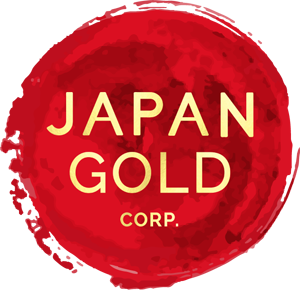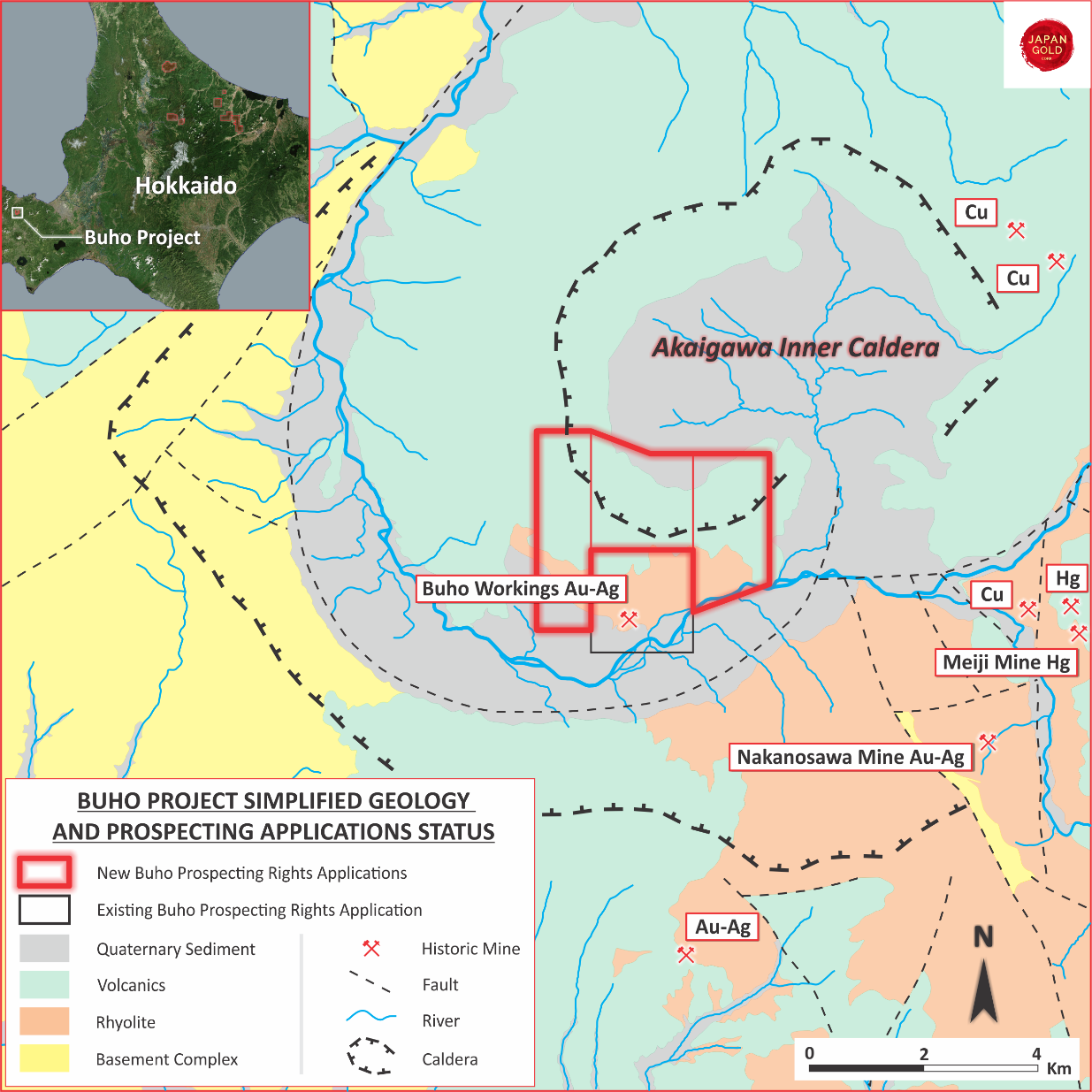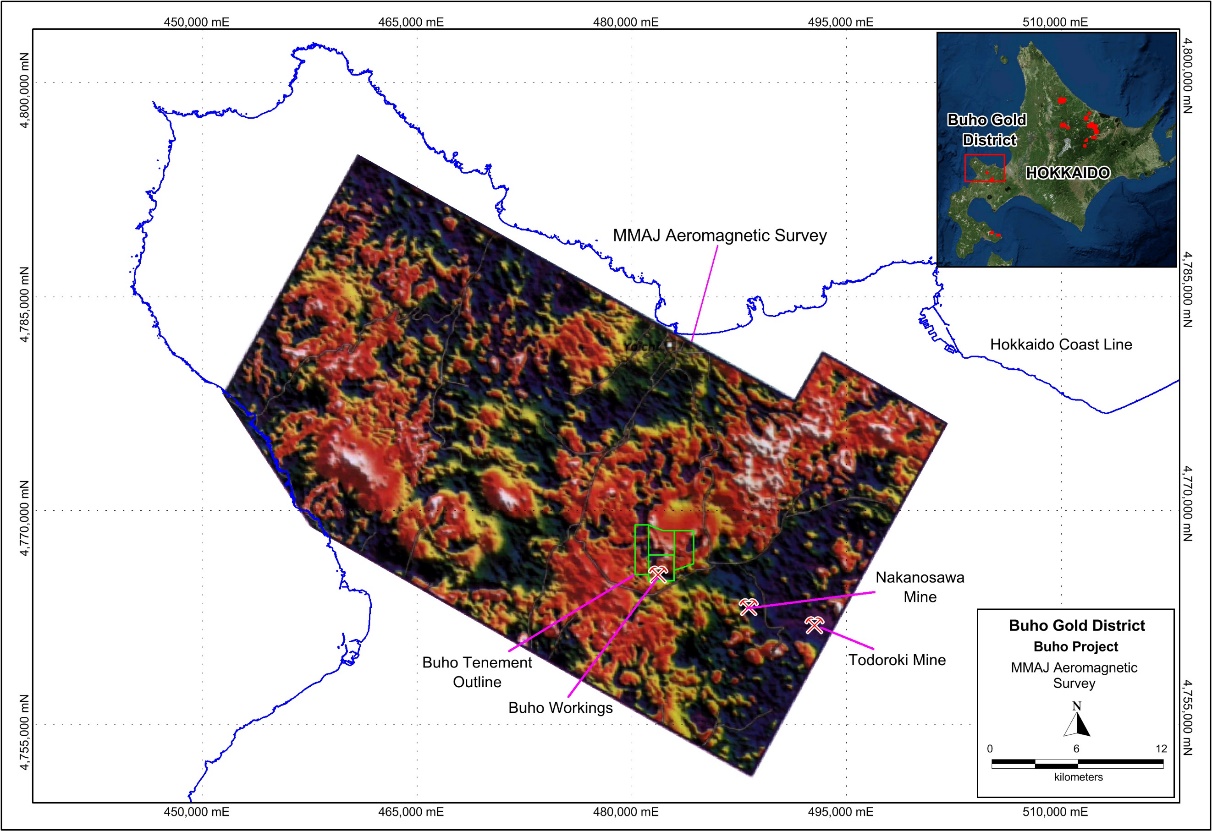The Buho Project
Highlights
- Japan Gold’s Buho Project is located within the Sapporo-Iwanai district of southwestern Hokkaido which contains at least 65 known gold-silver and polymetallic mineral deposits4.
- Historic epithermal gold mines within this district include Chitose (736,000 oz Au @ 14.5 g/t); Tiene (352,000 oz Au @ 7.5 g/t); Shizukari (256,000 oz of gold @ 7 g/t Au) and Todoroki (188,339 oz Au)
- Limited scout drilling in the 1990’s confirmed the occurrence of high-grade gold-silver veins located beneath the historic shallow Buho workings that were developed over a preserved, high-level epithermal system with intact sinter.
- Potential remains to discover high-grade gold-silver vein lodes beneath, and surrounding, the historic Buho workings.
- Potential for other known mineralization styles (Kuroko and disseminated base metal types) documented in the district have yet to be evaluated.
- Japan Gold believes that the previous exploration has been insufficient and that potential remains to discover high-grade gold-silver vein lodes beneath, and surrounding, the historic Buho workings.
- An initial program of 1) data compilation, review of MMAJ airborne magnetics and reprocessing of Austpac CSAMT data; 2) collection of an additional 10 line-km of CSAMT; 3) geological mapping and geochemical rock sampling; and 4) a scout-drill program, using a diamond rig to complete 3-4 drill-holes (1000 m) near the Buho workings is planned.
Project Details
The Buho Project comprises four contiguous prospecting rights application blocks (1,324 Ha) surrounding the historic Buho gold-silver mine and is located about 12 km west-northwest of the larger historic Todoroki gold-silver mine. Both of these historical mines form part of the Sapporo-Iwanai mineral district of southwestern Hokkaido.
History
The Buho Project lies within the Sapporo-Iwanai Mineral district, which contains at least 65 known gold-silver and polymetallic mineral deposits formed during the Neogene. Historic epithermal gold mines within this district include Chitose (736 Koz at 14.5 g/t Au, 2.7 Moz Ag), Tiene (352 Koz at 7.5 g/t Au, 4.2 Moz Ag) and Todoroki5 (188.3 Koz Au and 7 Moz Ag – 1METI, 1990). Kuroko-type deposits occur in the region, such as Toyoha (1.8 Mt Zn, 0.5 Mt Pb, 3 Kt Ag and 8 Kt Cu). There is no known gold and silver production reported from the historic Buho workings that lie within the tenement. These are believed to be near-surface workings developed in silicified rhyolite and associated with preserved hot-spring depositional features such as hydrothermal eruptive breccia and silica sinter.
The Buho workings and the immediate area were most recently explored by a joint venture between the Nisho Iwai trading company and the Australian company Austpac Gold NL (‘NICA JV’) in the early 1990’s. The NICA JV completed geological mapping, geochemical rock sampling, a CSAMT survey, two diamond and three percussion drillholes that tested beneath, and surrounding, the Buho workings. Soils above the Buho workings are enriched in mercury and the CSAMT survey defined strong resistivity contrasts suggesting hydrothermal alteration at depth. Six mine dump samples collected by the NICA JV averaged 1.9 g/t gold with a high of 9.1 g/t gold and 370 g/t silver. A 40 cm wide vein exposed in an upper adit assayed 5.0 g/t gold and 27 g/t silver. One diamond drill hole DDH-B1 intersected a zone of epithermal quartz-adularia breccia veins at about 100 to 140 m below surface, which returned a high-grade gold-silver intercept of 3.5 m at 21.8 g/t Au and 42 g/t Ag from 130.1 m (including 0.9 m @ 72.8 g/t Au and 65 g/t Ag – 2Austpac 1992). True widths were not reported or are unavailable. The best percussion hole (B4) interval was 0.4 m @ 10.0 g/t Au and 10 g/t Ag from 184.7 m. Exploration ceased after Austpac withdrew from the joint-venture and ceased its operations in Japan.
After the NICA JV exploration program, the Metal Mining Agency of Japan (‘MMAJ”) completed a regional exploration program over the mineral district including Buho, which entailed an airborne magnetics survey , but no detailed work was completed over the target area.
Geology and Mineralisation
The gold-silver mineralization style at Buho and other nearby deposits are classified as rift-related, low to intermediate sulfidation epithermal. Mineralization is typically associated with precious-metal and base-metal-bearing epithermal veins, characterized by pyrite, chalcopyrite, sphalerite, galena, electrum and tetrahedrite in a gangue of quartz, adularia, calcite, sericite and illite-smectite. Late-stage rhodocrosite and barite are common. Some of the deposits (e.g., Chitose) contain significant base-metals in the deeper parts of vein systems. The silver-gold ratios of the vein deposits are 5-50 and were formed from about 12-1 Ma4.
The Buho gold-silver workings are hosted by Pliocene rhyolitic lava, tuff and tuff-breccia that are underlain by Early Pliocene propylitic-altered, basaltic-andesitic volcanic rocks . Both rock units are overlain unconformably by andesitic volcanic rocks that comprise the southern margin of the Pleistocene Akaigawa caldera complex. The caldera hosts a number of mineral occurrences including the Todoroki gold mine, which produced 188.3 Koz5 of gold, the Meiji mercury mine and several base-metal vein deposits. Buho is perhaps the youngest of these deposits with silica sinter still intact, forming part of the relict hot spring system developed at the intersection of major structures with the caldera ring-fracture zone. At Buho, the major structures trend N070° E and are related to caldera development while subsidiary tensional structures trend north-south. Silica sinter is preserved near the top of the main east-west trending, silicified ridgeline. Immediately below the sinter, two historical exploration adits are developed on north-trending gold-silver-bearing, colloform-banded, quartz-chalcedony-adularia veins.
The historic Nakanosawa and Todoroki gold-silver mines occur outside of the project area, located 7- and 12-km to the east-southeast of the Buho workings, respectively. The larger Todoroki mine (188.3 Koz Au and 7 Moz Ag historic production5) consists of 12 gold-silver quartz veins hosted by Pliocene rhyolitic tuff-breccia units ranging from 0.8 to 4.5 m wide and extended up to 1200 m along strike and 220 m vertical, characterized by average mining grades of 2.3-6.2 g/t Au and 92-257 g/t Ag1.
Exploration Potential
The Buho Project is located within a productive mining district with known high-grade gold and silver occurrences. The limited amount of scout drilling completed by the NICA JV demonstrated the occurrence of high-grade gold veins located beneath the historic shallow Buho workings that were developed over a preserved, high-level epithermal system with intact sinter. Japan Gold believes that the previous exploration has been insufficient and that potential remains to discover high-grade gold-silver vein lodes beneath, and surrounding, the historic Buho workings.
An initial program of 1) data compilation, review of MMAJ airborne magnetics and reprocessing of Austpac CSAMT data; 2) collection of an additional 10 line-km of CSAMT; 3) geological mapping and geochemical rock sampling; and 4) a scout-drill program, using a diamond rig to complete 3-4 drill-holes (1000 m) near the Buho workings is recommended.
References
1METI (formerly known as MITI), 1990. The Report of Geological Structure Survey of Mineral Deposits of B Area in Northern Hokkaido”. The Agency of Natural Resources and Energy of MITI, March 1990.
2Austpac Gold NL. Company Reports, 1988 to 1994
3Kabashima, T., Arai, E., Hosoi, Y., 2000, Resource evaluation of mineral deposit in southern Hokkaido, Japan, utilizing airborne magnetic and radiometric data. 資 源 地 質,50(1),11
4Watanabe, W., 2002, Late Cenozoic Metallogeny of Southwest Hokkaido, Japan. Resource Geology, vol. 52, no. 3, pp 191-210
5Garwin, Hall, Watanabe, 2005. Tectonic Setting, Geology, and Gold and Copper Mineralization in Cenozoic Magmatic Arcs of Southeast Asia and the West Pacific, Economic Geology 100th Anniversary Volume pp. 891–930




